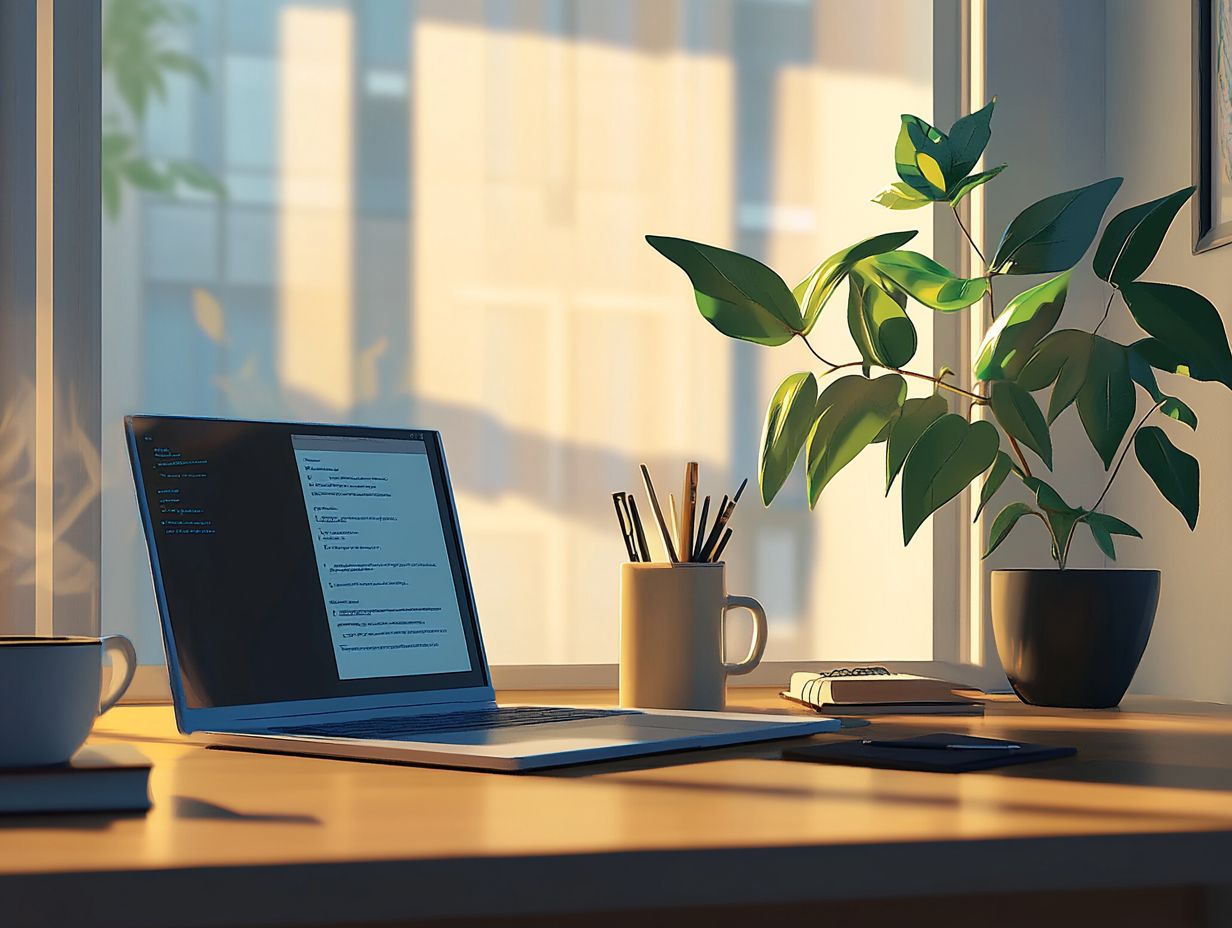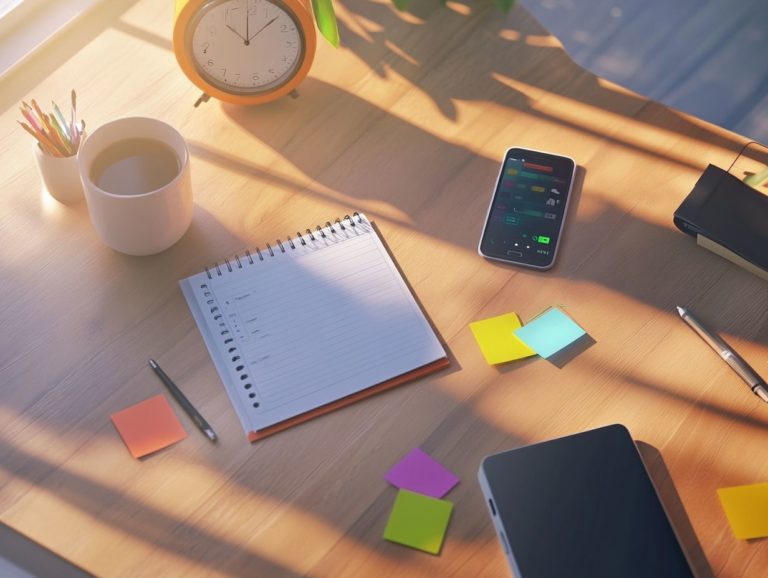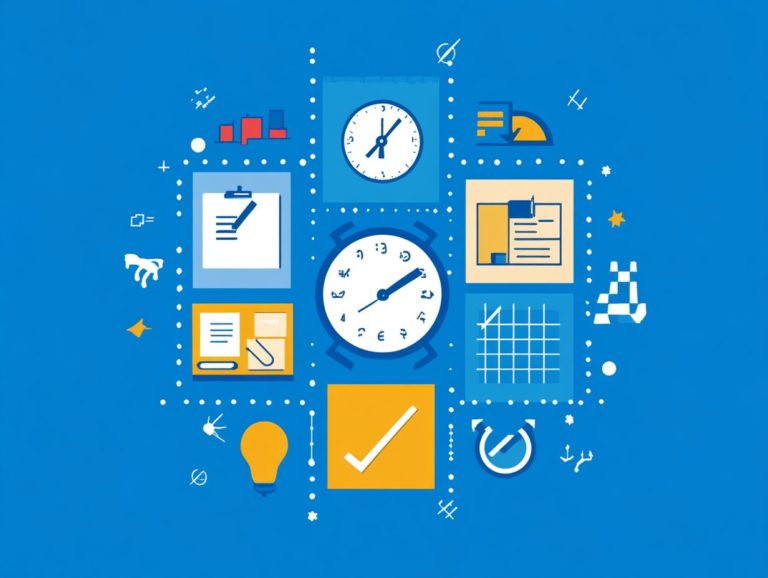FAQs on Utilizing Downtime Productively
In our fast-paced world, downtime can feel like a luxury we can’t afford. But taking these breaks can actually boost your productivity and well-being!
This article delves into the importance of downtime, providing valuable insights on how to make the most of these opportunities for growth and relaxation. From strategies to stay productive during quieter moments to the mental and emotional benefits you can gain, you’ll discover how to optimize your downtime for self-improvement and find balance amidst your busy life.
Explore how to transform moments of pause into meaningful experiences that enhance your daily routine.
Contents
Key Takeaways:

- Unlock your potential during downtime! Here s how: Maximize downtime by setting clear goals and prioritizing tasks.
- Utilize downtime for self-improvement through learning new skills or engaging in hobbies.
- Balancing productivity and rest can reduce stress and improve well-being.
Understanding Downtime
Understanding downtime is essential for boosting workplace productivity and ensuring employee satisfaction. You can categorize downtime into planned and unplanned, both of which carry considerable implications for how resources are used, employee creativity, and overall operational efficiency.
It’s important to recognize how downtime can affect both mental and physical health. Unstructured periods can lead to burnout or a dip in motivation. Striking a balance between structured downtime and scheduled breaks is vital, especially in remote work settings where flexibility plays a crucial role in maintaining a healthy workflow.
Defining Downtime and Its Importance
Downtime refers to moments when employees aren t fully engaged in productive work, due to scheduled breaks or unexpected interruptions. It plays a crucial role in overall productivity.
It s important to grasp the different types of downtime. Planned downtime is built into work routines, offering necessary moments for rest and renewal, while unplanned downtime can result from unforeseen events. Both types serve vital functions in maintaining mental and physical well-being.
For example, taking regular breaks can significantly enhance your concentration and spark a more creative mindset, empowering your team to generate innovative ideas.
Downtime provides an opportunity for employees to recharge. This helps reduce stress and combat burnout, leading to improved productivity and collaboration within teams. Emphasizing the significance of these breaks underscores their role in fostering a healthier workplace and achieving more effective outcomes.
Productivity During Downtime
Maximizing productivity during downtime is crucial for optimizing your workflow and sustaining high levels of efficiency and employee satisfaction. Understanding how to utilize downtime for productivity emphasizes the delicate balance between work and rest, ensuring that you make the most of every moment.
Ways to Make the Most of Downtime

Making the most of your downtime requires strategic planning. Structured breaks can significantly enhance your creativity and improve overall efficiency.
To capitalize on every moment, consider engaging in targeted training programs that align with your personal goals or team objectives. Regularly scheduled breaks not only recharge your mental batteries but also boost your focus when you return.
Implementing techniques like the Pomodoro Technique, which involves working for a set period and then taking a short break, can further elevate your productivity.
This rhythmic approach cultivates a more invigorating work environment and maximizes your output during available work hours, transforming what might seem like idle time into valuable opportunities for growth and learning.
Mental and Emotional Benefits of Productive Downtime
Productive downtime can greatly boost your mental and emotional well-being. It serves as a vital counterbalance to workplace stress and burnout that many employees face.
By integrating moments of intentional rest, you can foster a healthier work-life dynamic. This ultimately leads to greater productivity and satisfaction in your professional life.
Reducing Stress and Increasing Well-Being
Reducing stress through purposeful downtime can enhance your emotional health and overall well-being. This is crucial for maintaining high productivity levels.
Cultivating effective breaks is essential, as they provide the opportunity to recharge and return to your tasks with renewed focus.
By incorporating mindful activities like deep breathing or short meditative sessions, you can significantly alleviate tension and improve clarity of thought.
When you prioritize your mental well-being during these moments, you enhance your emotional resilience and contribute to a harmonious work environment.
Recognizing the connection between restful pauses and efficiency allows you to unlock your full potential. This fosters a culture that values mental health as a pathway to superior performance.
Utilizing Downtime for Self-Improvement
Leveraging downtime for self-improvement is a powerful strategy that enhances your skills and knowledge. This proactive approach fosters your personal growth and significantly contributes to the advancement of your organization.
Learning New Skills and Hobbies

Exploring new skills and hobbies during your downtime can enhance your engagement and lead to a more fulfilling work experience.
By actively seeking out opportunities to learn, you elevate your professional capabilities and enrich your personal life.
Consider diving into workshops on coding, graphic design, or project management. These pursuits enhance your resume and refine your critical thinking and problem-solving abilities.
Alternatively, immersing yourself in hobbies like painting, photography, or writing can ignite your creativity. This paves the way for innovative approaches in your daily tasks.
Engaging in these activities fosters personal growth and cultivates greater job satisfaction. This also contributes to a collaborative work environment that benefits the entire organization.
Managing Downtime in a Busy Schedule
Effectively managing downtime in a busy schedule is crucial for maintaining peak productivity and achieving a harmonious work-life balance. It allows you to recharge and rejuvenate without sacrificing performance.
Embracing these moments enhances your well-being and ensures you can tackle responsibilities with renewed energy and focus.
Tips for Balancing Productivity and Rest
- Schedule regular breaks throughout your workday to provide mental and physical recharge.
- Embrace time management tools, such as productivity software, to prioritize tasks and streamline workflows.
- Use techniques like the Pomodoro Method to enhance focus while ensuring necessary rest intervals.
- Make it a point to recognize your peak work hours and align your most challenging tasks accordingly.
This thoughtful alignment nurtures both your productivity and overall well-being.
Frequently Asked Questions
What is considered downtime?

Downtime means any time when you re not actively working. This includes breaks, commute time, and other free time throughout the day.
Implement these strategies in your daily life to maximize your downtime effectively. Share your experiences and let others know how you make the most of your productive pauses!
How can I use downtime productively?
Make the most of your downtime! Here are a few ideas:
- Read a book or article.
- Learn a new skill.
- Check off a task from your to-do list.
- Exercise to boost your energy.
- Practice a hobby you enjoy.
Why is it important to use downtime productively?
Productive downtime leads to personal growth, increases efficiency, and promotes a healthy work-life balance. You’ll feel more relaxed and energized!
What are some strategies for using downtime effectively?
Some effective strategies include:
- Planning ahead.
- Setting specific goals for your downtime.
- Doing activities that help you grow both personally and at work.
How can I make the most of short periods of downtime?
Even short periods of downtime, like waiting in line or during a commute, can be productive. Here are some suggestions:
- Listen to audiobooks or podcasts.
- Review notes or to-do lists.
- Practice mindfulness or deep breathing exercises.
What are some potential challenges in using downtime productively?
Recognizing these challenges is the first step to overcoming them now! Some common challenges include:
- Distractions.
- Lack of motivation.
- Difficulty finding activities that align with your goals.






